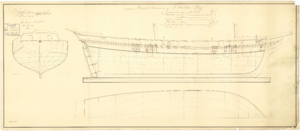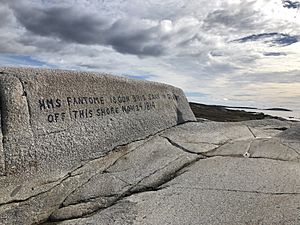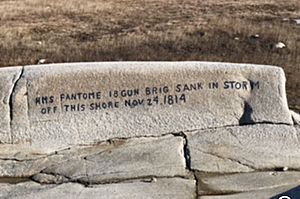HMS Fantome (1810) facts for kids

Fantome
|
|
Quick facts for kids History |
|
|---|---|
| Name | Fantôme |
| Owner | Robert Surcouf |
| Port of registry | St. Malo |
| Launched | 1809 |
| Fate | Captured by Royal Navy ships Melampus and Driver 28 May 1810 |
| Name | HMS Fantome |
| Acquired | by capture, 28 May 1810 |
| Commissioned | 4 August 1810 |
| Honours and awards |
Naval General Service Medal with clasp "April & May Boat Service 1813" |
| Fate | Wrecked, 24 November 1814 |
| General characteristics | |
| Type | Brig |
| Tons burthen | 3806⁄94 tons (bm) |
| Length |
|
| Beam | 30 ft 11 in (9.4 m) |
| Depth of hold | 13 ft 0 in (4.0 m) |
| Complement | 74 |
| Armament |
|
HMS Fantome was a fast, 18-gun brig-sloop (a type of small warship) that served in the Royal Navy of Great Britain. She was originally a French privateer brig named Fantôme. A privateer was a private ship given permission by a government to attack enemy ships.
The British captured Fantôme in 1810 and made her part of their own navy. Renamed HMS Fantome, she played a big role in the War of 1812. Sadly, she was lost in a shipwreck near Prospect, Nova Scotia, close to Halifax, in 1814.
Contents
Building and French Adventures
The Fantôme was built in 1809 in St. Malo, France. A famous French privateer captain named Robert Surcouf had her built. She was designed as a privately owned corvette brig.
On her very first trip, the brig sailed to Isle de France (Mauritius) in the Indian Ocean. She was an armed transport ship, meaning she carried goods but also had permission to attack enemy ships. Fantôme had 20 heavy carronades (a type of short cannon) and a crew of 74 men. She managed to capture three ships. One of them was a ship called William. Fantôme took money and goods from William, but then let the ship go.
Captured by the British
On May 28, 1810, the British frigate Melampus and the sloop Driver spotted Fantôme. This happened in the middle of the Atlantic Ocean as Fantôme was returning from the Indian Ocean. The British ships captured her.
Fantôme was then taken to the Halifax Vice admiralty court in June 1810. A Vice Admiralty Court was a special court that dealt with naval matters, like captured ships. The court decided she was a legal prize of war. The Royal Navy then took her into their service as HMS Fantome. She was refitted (repaired and updated) at the Halifax naval yard to suit British needs. In 1811, she officially joined the British fleet under Commander John Lawrence.
Early British Service
HMS Fantome first served in the North Sea. On November 12, 1811, she sailed towards Portugal. During this time, Fantome stopped a ship called Canton and sent her to Lisbon.
On December 4, 1812, Fantome set sail for North America. This was just before the War of 1812 began.
War of 1812 Battles
In February 1813, during the War of 1812, Fantome joined a group of British warships. This group was off the American coast and led by Admiral Sir John Borlase Warren. Fantome helped capture several enemy ships, including Gustavus and Staunch on February 24. She also shared in the capture of Christiana and Massasoit in March.
On March 4, 1813, Fantome captured and destroyed an American schooner (a type of sailing ship) named Betsy Ann. This ship was carrying flour from Alexandria to Boston. Fantome also shared in the money from capturing another ship, the General Knox, on March 17.
Operations in Chesapeake Bay
On April 3, 1813, five enemy armed ships were seen in Chesapeake Bay. They were near the Rappahannock River. British ships, including Maidstone, Statira, Fantome, Mohawk, and Highflyer, chased them into the river. Small boats from the British squadron, led by Lieutenant Puckingthorne, rowed 15 miles upriver.
There, they found four armed schooners lined up. The British captured three of them: Lynx, Racer, and Dolphin. The British lost two men killed and 11 wounded in this fight. Fantome had no casualties.
After capturing these ships, the British squadron continued up the Chesapeake Bay. Admiral Warren ordered Rear Admiral George Cockburn to explore the rivers at the top of the bay. Cockburn took Maidstone, Fantome, Mohawk, Highflyer, and three of the captured schooners. He also had 180 sailors and 200 marines with him.
On April 28, Cockburn learned about supplies of flour and military equipment at French Town on the Elk River. He went aboard Fantome and took other ships up the river. That night, 150 marines and five artillerymen went in boats to destroy the supplies. They found that the Americans had set up a six-gun battery. The battery fired at the boats, but the British ships' cannons quickly silenced it. The British then burned the supplies and five vessels.
Later that morning, Captain Lawrence of Fantome took some cows from a local owner, paying him with official navy bills. He then rejoined Rear-Admiral Cockburn near the mouth of the Susquehanna River. After seeing Americans firing from a new battery at Havre de Grace, the Admiral decided to attack it. Captain Lawrence led this operation. At dawn on May 2, boats with 150 marines and artillerymen attacked. They drove off the defenders and captured the battery.
A group of boats then rowed upriver to the Cecil or Principio Foundry. They destroyed the buildings, machines, and guns there. They also destroyed five vessels and a large store of flour. They returned to their ships by 10 p.m., after being away for 22 hours. Captain Lawrence was praised for his bravery and leadership in this operation.
On April 29, boats from several ships, including Fantome, went up the Elk River. Their goal was to destroy American ships and supplies at French Town. On the way, a battery at Havre de Grace fired at them. A landing party then destroyed the battery and burned much of the town. Years later, a special medal was given to those who took part in these actions.
On April 30, Highflyer helped Fantome and Mohawk gather cattle for the fleet. They paid for the cattle with official navy bills. The next day, they got more cattle from Spesutie Island.
On April 29, Fantome recaptured an English brig called Endeavour. An American privateer had captured Endeavour while she was carrying wine. The recaptured Endeavour reached Bermuda by the end of June.
Fantome also shared in the money from capturing other ships, including Pilgrim on May 18 and Rolla on May 29.
Helping Enslaved People
While operating in the Chesapeake Bay, Fantome helped several families of enslaved African Americans. These families had escaped from plantations during the War of 1812. Fantome gave safety to seven escaped enslaved people on May 30, 1813. They then joined Fantome's crew. Two of them even used Fantome as a base to go back to shore and rescue their enslaved wives and children.
More Captures
Fantome continued to capture enemy ships. She shared in the money from capturing the Spanish brig St. Iago on June 11. The next day, she helped capture the American schooner Surveyor. She also shared in the capture of other American ships like Governor Strong, Emily, and Star in June. On June 26, Fantome captured Cida de de Leira, a brig carrying wool, salt, wine, and even 23 Merino sheep from Lisbon to Boston.
On July 9, Fantome recaptured the brig Seaflower. She also recaptured another unnamed brig that was sailing from Newfoundland to Barbados.
On October 5, Fantome and Epervier recaptured the Liverpool Packet off Mount Desert Island, Maine. This ship was a former Nova Scotian privateer that was now sailing as an American privateer called Portsmouth Packet. They chased her for 13 hours. The Portsmouth Packet had five guns and a crew of 45. The recaptured ship was brought to Halifax. Her original owners bought her back and changed her name back to Liverpool Packet.
About a month later, on November 3, Epervier and Fantome captured Peggy. This ship was carrying timber and wood.
Captain Lawrence was honored for his service. In November 1813, Commander Thomas Sykes took over command of Fantome.
Journey to the Great Lakes
On January 21, 1814, Lieutenant Henry Kent of Fantome volunteered to serve on the Great Lakes. He joined 210 volunteer sailors from Fantome and other ships. Seventy men left Halifax on January 22 for Saint John, New Brunswick. From there, they traveled by sleighs for 80 miles to Fredericton.
They then traveled along the ice of the Saint John River. After 82 miles, at Presque Isle, they switched from sleighs to toboggans. They were also given snowshoes and moccasins. Leaving on February 8, they traveled between 15 and 22 miles a day through deep snow along the St. Lawrence. They reached Quebec on February 28. They finally arrived at Kingston, Ontario, on March 22.
On May 9, 1814, Fantome captured the Spanish brig Danzic. This brig was sailing from Bath to Bermuda with lumber and shingles. She was sent to St Johns, New Brunswick.
The Shipwreck
On November 24, 1814, Fantome ran aground (hit the bottom) in Shad Bay. This was near the village of Prospect, Nova Scotia. The brig was guiding a group of ships from British-controlled Castine, Maine to Halifax, Nova Scotia.
On the evening of November 23, Captain Sykes ordered a course towards the Sambro Light. At 2 AM the next morning, he ordered a depth sounding. When it showed only 35 fathoms (about 210 feet), he ordered a change of course. An hour later, he found that the pilot had changed his order back. Soon after, the ship struck the bottom.
Sykes ordered the masts to be cut away and the boats to be lowered. But Fantome quickly filled with water. The crew got into the boats in an orderly way, and everyone reached the shore safely.
A naval court later looked into the shipwreck. Captain Sykes was criticized for not checking the depth often enough and for trusting the pilot too much. The officer on watch was told to be more careful. The master of the ship was strongly criticized for not taking continuous depth readings and for not telling the captain his concerns. The pilot, Thomas Robinson, was severely criticized for changing the captain's order and for sailing too close to shore without checking the depth. He lost all his pay.
Two schooners from the same group of ships, Industry and Perseverance, were also lost in the same area. Another transport brig from the group ran aground elsewhere that night but was later pulled free. No one died when these ships sank.
After the Shipwreck
Some people have claimed that the ships Fantome was escorting were carrying treasures taken from the White House. This was during the British raid on Washington, D.C.. However, Fantome was not involved in the Washington raid. Historians agree that the ships were carrying goods and money from Castine. Today, the spot where Fantome was lost is marked by an inscription on a large granite boulder near the wreck site at Prospect.



